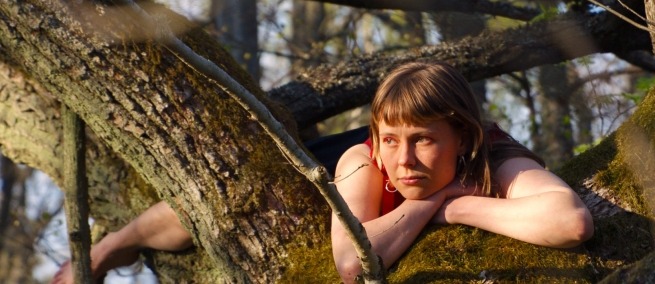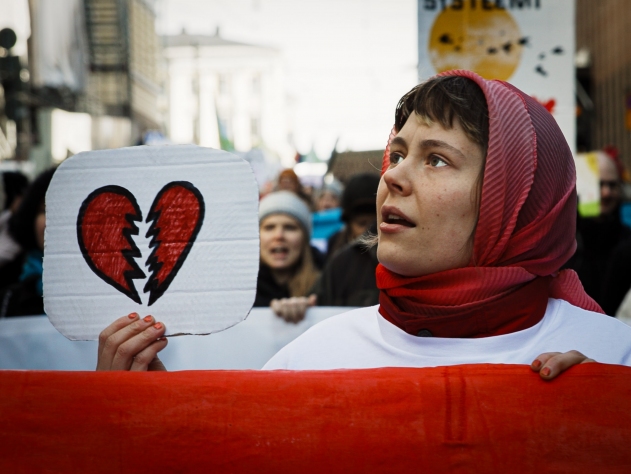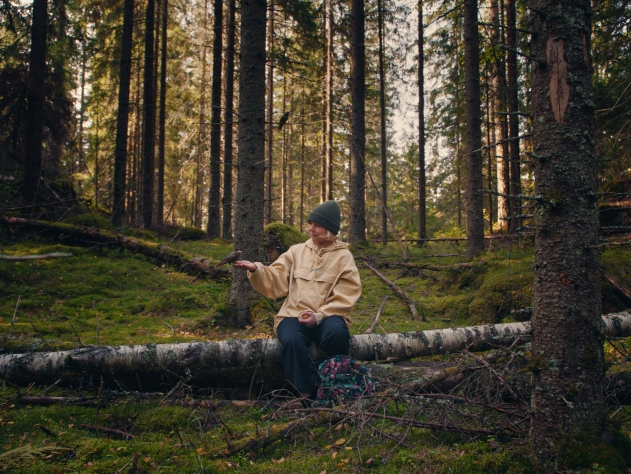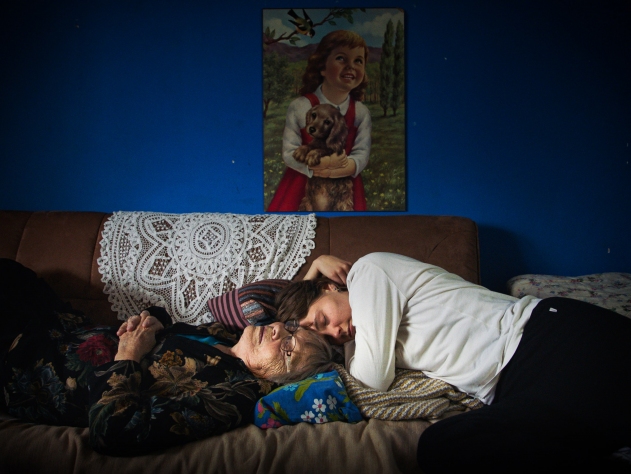
Following two eco-activists in Finland, ONCE UPON A TIME IN A FOREST finds a rare balance between showing the mettle of its protagonists and the beauty of the forests they fight to preserve. Documentary filmmaker Virpi Suutari recruited a blue-chip nature cinematographer, Teemu Liakka, to faithfully render the enchantment of the woods and observe twentysomething Ida Korhonen and Minka Virtanen undertaking a range of protests. Citing Kelly Reichardt (FIRST COW) and Finland’s own Pirjo Honkasalo as two admired filmmakers, Suutari is a veteran of over 30 films and premiered this latest documentary at CPH:DOX last month. I spoke with her via Zoom from Helsinki before her next screenings in Visions du Réel and Hot Docs.
How did you choose Ida and Minka as the two eco-activists to focus on?
I met Minka when she was taking part in the Extinction Rebellion. I went to meet a group of people from Extinction Rebellion and they had formed a Forest Rebellion group, part of a bigger grassroots movement, The Forest Movement. I instantly saw that there was something interesting about Minka. And when we were pre-shooting something, I noticed she has almost a film star quality—a very beautiful, delicate presence and nuanced existence in front of the camera, and the right kind of rhythm. Ida caught my interest because she has this very interesting complexity in her personality. On the one hand, she’s like a child, [but like] a genius child whose parents forgot to pick her up in the kindergarten yard. But then the next moment she can be a very strategic thinker. She spreads her war maps in front of her and starts to command her troops!
I followed them for one and a half years, and we edited a few scenes for them to see, so they could get an idea of how I’m looking at them, and the atmosphere in the film. I think that was a very big part of gaining their trust.
Your film shows the beauty of the Finnish forests—not playing it up, but just reminding us how it looks and feels to be in a forest.
Yeah, it was very important for the film that it comes from the protagonists, not something superficially added. Ida spoke a lot about her deep love for the forest. It’s a very deep emotion, almost physical. And they spend a lot of time in nature as well. Ida doesn’t even need any mittens when it’s like minus 35 degrees! She has become like one of the creatures in the forest. So it was very evident that we need these forest scenes in order to have this non-verbal information about why they are doing what they are doing. And to have this timeless feeling, because of course this is a burning political subject, but the question is about more timeless things—things that were here before us humans and that will remain after us as well.
Hopefully!
Yes, hopefully! It was also important to have these nature scenes in order to lure the viewer inside, to listen to what these young people have to say. Because it’s often problematic when activists have a very strong agenda and are trying to teach you something, and you reject that very easily because you don’t want to listen when someone is preaching to you. So it was delicate how to balance all this, and we also didn’t want to make a film that would arouse anger or antipathy, because there is a lot of antipathy and even aggression against activists. I think basically they make us feel guilty of our own moral laziness. And I’m talking about myself [too]. We wanted to make people understand the ideas and actions behind those moments when we see them in the streets.

Still from ONCE UPON A TIME IN A FOREST. Photo by Teemu Liakka. ©Euphoria Film.
How did you work with the cinematographer on portraying the forests as well as protest actions? They seem to require different approaches, maybe one more dynamic.
I had one of the best nature cinematographers on my team. He could work in a way that didn’t disturb [the protagonists] too much. And also my sound person was learning to be a nature surveyor, surveying endangered species. I think that was also a big part of gaining their [the protagonists] trust. But yeah, the cinematographer Teemu Liakka has made quite a few polished nature films, like TALE OF THE SLEEPING GIANTS, like National Geographic films. We talked about how he had to downgrade what he does a bit, so that it doesn’t feel like too much for this particular film. We also decided that the animals that we see in the film must be the kind that anyone could meet in the nature, not all bears or wild animals like that. And before he started doing other cinematography, he used to specialize in diving, and we were able to use that skill as well [for the scenes of Minka diving]. I got that idea because Minka had put some diving images of herself on her Instagram. We also knew it was possible to have fish [in the shot]. Finland has tens of thousands of lakes. Many have suffered from pollution and are not that clear water anymore, but this particular lake is in the eastern part of Finland.
I think showing the forest’s beauty also conveys the sense of what we could lose.
Yeah, and it has to do with this generational sorrow, this environmental sorrow. Most of us have those feelings, but I think this generation is really having them and they see very clearly stuff that we don’t want to think about that much. So for me this is a generational film as well, and it’s been heartbreaking to see how this generation has already started to prepare itself for losing certain things. They are anticipating that, “Okay, we are losing this and that, but we are still trying to save at least something.” So that diving scene is a reminder that we still have these places, and we have to save them.

Still from ONCE UPON A TIME IN A FOREST. Photo by Teemu Liakka. ©Euphoria Film.
You change the aspect ratio in the diving scene, and other moments, too, right?
Yes, we have the cinemascope ratio in the beginning and in the middle with the diving scene and then in the end. Otherwise it’s 4:3, and the reason was that I was going to use more archive materials than I eventually ended up using. But I kept [the 4:3 ratio] in the film, because it felt like a very cozy aspect ratio for these young people, and it has a touch of nostalgia also. You get very near to them. But then we used the ’scope in those moments of freedom and when they are really in nature. Big love scenes for a forest!
Could you talk about Minka and Ida’s ideas about the forest, in the context of climate change but also for Finland’s vast forests specifically?
The Extinction Rebellion is about climate change, but I think in Finland, they realize that they have to concentrate more on forests, because it’s very concrete and we can really do something about it. In Finland there are 600,000 private forest-owners, and we have like 5.5 million people living in Finland. So it’s quite a big group of people and families having private forests. I am one of the forest owners, a very small one, and I started to think about what would I do with my forest. And then we have the [state] forest administration, which is under political governance. That belongs to all of us, so we are all forest owners here in Finland in one way or another. And what these youngsters are trying to do is make us see that our forests are not in as good a state as we generally think.
We are still living in the past in Finland, because after the Second World War, we needed the forest industry very badly. It helped us pay our war debts to the Soviet Union, and there was a big state program to build up the forest industry. And there are a lot of fictional films about these forest workers—the lumberjack was sort of a sex symbol. My parents met in forest work. My father, in the beginning of the 60s, went to work as a lumberjack, and my mother was cooking there. So the forest industry is really part of all our mental history. But we have over logged our forests, and there is a lot of biodiversity loss. We have broken the big forest areas into small parts, and the species can’t survive anymore.
So these young people are trying to make us see what is happening behind the scenes. Of course, there is a lot of diplomacy and negotiations—Greenpeace is negotiating all the time with the forest administration and the forestry companies and so on. But the activists are doing an important job of making public all that is happening, like that there is still clear-cutting. They are not telling us that we have to stop all forest industry. They are not naive. But we should protect more. It’s so easy to say, oh, these youngsters are so black-and-white and so idealistic. But their message is basically the same as what the researchers have been telling us.
What was it like filming their protests? You’re with them blocking a logging road, for example.
To tell you the truth I’ve been scared of police since I was a child. I always felt guilty when I saw a policeman, I don’t know why. But I’m not anymore! I know that the activists have different experiences, but the policemen in the film reminded me a bit of the police in FARGO—very kind, very polite. [laughs] There wasn’t this aggression that you normally see in an activist film, so that was surprising. But of course, sometimes it was heated to be in those situations and trying to capture it, like in the scene when Ida and the other girl were going to stop the logging machine in the dark, when it was minus 25 degrees. They went with their skis and said, “Oh, it’s easy to ski here.” There was snow up to the waist of the cinematographer who had this very heavy camera. And I was really afraid that the trees would fall on somebody’s neck! My editor told me that we don’t see this kind of scene so often in fiction films because it would require like 50 people to arrange it. It was only three of us plus the protagonists.
You also show them protesting inside a corporate office.
That was probably the most nerve-wracking situation for me. In the end, we had to leave with the others. But in Finland, you can film the police. And I also got some legal consultation along the way in order to protect the protagonists. I wanted to make sure that the film wouldn’t harm them. You can never be sure how the prosecutor can use your film if they are building up a bigger case against the young people. I gave that consultation to the protagonists as well. I’ve never made a film of people who have such a strong agenda. It’s quite demanding for the filmmaker: how to be close and distant at the same time, and how to remind them that I am not one of them. Even though I love you guys, my heart is with you! But I think it helped me that I’ve made films for such a long time, and I worked as a journalist before I became a filmmaker. So I know my boundaries also. But you really are so enchanted by their personalities, and they start relying on you and asking for things.

Still from ONCE UPON A TIME IN A FOREST. Photo by Teemu Liakka. ©Euphoria Film.
What were they asking for?
Well, Ida, when we were up in Lapland, she was like, “You must organize the snowplow so we can get out there and build our camp.” Very practical, giving me orders. But I love that side of her. She was 22 when we started filming her, and I’m so curious to know what she will do in 10 or 15 years. I’m sure she’ll be in some big position, doing something significant. She’s a bit like a Greta Thunberg personality. There is a similar kind of concentration. She’s so clear. My composer said to me that it’s so difficult to compose anything related to Ida, because it’s so crystal clear where she’s going. Everything felt to my composer so silly and superficial related to Ida. I kind of get it!
Was it important to you to include older generations in the film? Ida’s grandparents have differing reactions to her work...
Yeah, that was really important for the film. That’s our little window to the past, to this forest industry narrative I was talking about. So it was very meaningful to include that. And my mother is from the countryside as well, from the eastern part of Finland. That’s where I have now the forest with my sister. When my mother died two years ago, we inherited that small forest, and I think making this film has to do with my own process of losing my mother as well. That forest has a lot of family memories embedded in it. And I think most Finnish children have these memories that we’ve been just playing in the forests all the time. That was my place. So the forest industry is looking at our forests as an economical asset, but for most Finns, we have very spiritual memories from the forests. Eighty percent of Finns want to protect more. So there is a big contradiction between what we want and what is actually happening.
♦
TOPICS